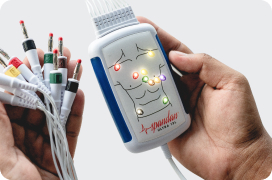
Related Article
Author:- Mr. Ritesh Sharma
Electrocardiograms (ECGs) are essential tools in modern cardiology, used to detect and diagnose various heart conditions by recording the electrical activity of the heart. Understanding the different ECG wave types is crucial for both healthcare professionals and patients to interpret the results accurately. This blog will explore the fundamental ECG wave types, their significance, and what abnormalities might indicate about heart health. Let’s delve into the intricacies of these ECG wave types to gain a comprehensive understanding.
What is an ECG?
An ECG records the electrical signals generated by the heart as it beats. The standard ECG consists of several key waveforms that represent different phases of the cardiac cycle. By examining these waveforms, medical professionals can assess the heart’s rhythm, identify any abnormalities, and diagnose various cardiac conditions. The primary ECG wave types are P waves, QRS complexes, T waves, and occasionally U waves.
P Wave
The P wave represents the atrial depolarization, which is the electrical activity that initiates atrial contraction. It is the first wave in the ECG cycle and is usually small and rounded. The P wave provides critical information about the atrial activity of the heart.
Significance:
- Normal P Wave: Indicates normal atrial activity and rhythm.
- Abnormal P Wave: Can indicate atrial enlargement, atrial fibrillation, or other atrial abnormalities.
QRS Complex
The QRS complex is a crucial component of the ECG, representing the depolarization of the ventricles, which triggers ventricular contraction. It consists of three distinct waves: Q, R, and S.
Significance:
- Normal QRS Complex: Indicates normal ventricular depolarization.
- Wide QRS Complex: May suggest ventricular hypertrophy or a conduction block.
- Narrow QRS Complex: Typically indicates normal ventricular conduction but may be seen in conditions like supraventricular tachycardia.
T Wave
The T wave represents ventricular repolarization, which is the process of the ventricles returning to their resting state after contraction. It follows the QRS complex and is typically upright in most leads.
Significance:
- Normal T Wave: Indicates normal ventricular repolarization.
- Abnormal T Wave: Can indicate ischemia, electrolyte imbalances, or ventricular hypertrophy.
U Wave
The U wave is a less commonly discussed ECG wave type but can be significant in certain conditions. It follows the T wave and is usually small and upright.
Significance:
- Presence of U Wave: Can be normal or may indicate conditions such as hypokalemia, hypercalcemia, or hyperthyroidism.
- Absent U Wave: Typically not a cause for concern but should be evaluated in the context of the entire ECG.
ECG Wave Types in Abnormal Conditions
Atrial Fibrillation (AFib)
In atrial fibrillation, the atrial electrical activity becomes chaotic, leading to irregular and often rapid heart rates. The P wave is absent, and the baseline may appear wavy.
Ventricular Tachycardia (VT)
In ventricular tachycardia, the ventricles beat very quickly and out of sync with the atria. This is seen as wide and bizarre QRS complexes, often without discernible P waves.
Myocardial Infarction (Heart Attack)
During a myocardial infarction, the heart muscle is deprived of oxygen. This can cause several changes in the ECG wave types:
Hyperkalemia
High potassium levels can affect the ECG wave types significantly:
Hypokalemia
Low potassium levels can lead to different ECG changes:
- Flattened or inverted T waves.
- Prominent U waves.
- Prolonged QT interval.
Practical Application of ECG Wave Types
Understanding ECG wave types is crucial for diagnosing and managing cardiac conditions. For example, emergency medical technicians (EMTs) use ECGs to quickly assess heart rhythms in critical situations, allowing them to administer appropriate treatments promptly. Cardiologists rely on detailed ECG analyses to plan long-term treatment strategies for patients with chronic heart conditions.
In conclusion, mastering the interpretation of ECG wave types is essential for anyone involved in cardiac care. The P wave, QRS complex, T wave, and U wave each play a critical role in providing a comprehensive picture of the heart’s electrical activity. By understanding the normal and abnormal patterns of these ECG wave types, healthcare professionals can diagnose and treat a wide range of cardiac conditions more effectively.
ECG wave types offer invaluable insights into the heart’s health, helping detect everything from atrial fibrillation to myocardial infarctions. Whether you are a medical professional or a patient looking to understand your ECG results better, having a firm grasp of these wave types can significantly enhance your knowledge and ability to manage heart health.
By recognizing the significance of each ECG wave type and their implications for various heart conditions, we can ensure timely and accurate diagnosis and treatment, ultimately improving patient outcomes and heart health management.
Understanding ECG wave types is not just about interpreting squiggly lines on paper; it’s about decoding the language of the heart to save lives. With advancements in technology and continuous learning, we can look forward to even more precise and effective use of ECGs in the future.




